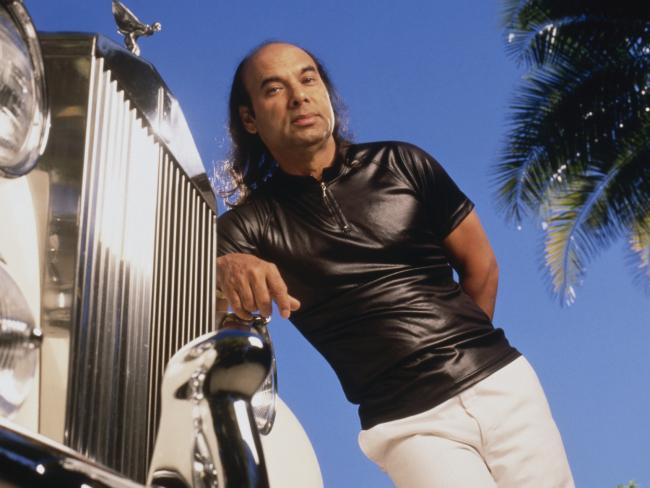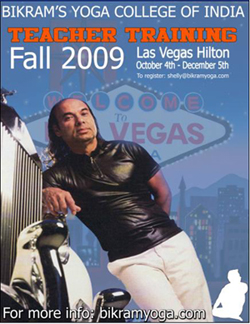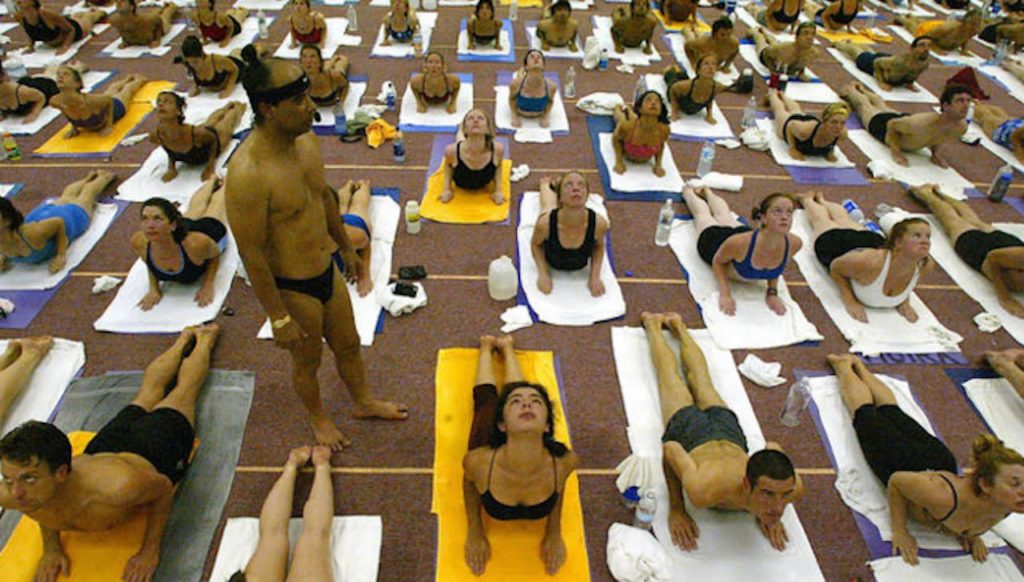bikram yoga: good or bad?

 Bikram is thought of by many yogis as “not real yoga,” whatever that means. Why? Well, it’s incredibly body oriented, and most people attracted to it (it seems to me) are primarily interested in their bodies lookin’ good, as there isn’t much attention to anything but forcing yourself, asana, and some heating pranayama.
Bikram is thought of by many yogis as “not real yoga,” whatever that means. Why? Well, it’s incredibly body oriented, and most people attracted to it (it seems to me) are primarily interested in their bodies lookin’ good, as there isn’t much attention to anything but forcing yourself, asana, and some heating pranayama.
What’s wrong with that? Nothing. It is what it is. A bikram yoga studio is heated to a recommended 105° F/40.5° C to assist flexibility (warm bodies are more flexible than cold) and sweat, with the hope of detoxifying the body. Bikram Choudhury (the founder) has gained attention for claiming trademark and copyright on his sequence of 26 yoga asanas (poses) and threatening to sue anyone who teaches them without his approval. “This is enlightenment?” many ask, including Nora Isaacs at salon.com. Apparently so, as Bikram has compared his speedoed self to the Buddha.
How do I feel about Bikram yoga? Mixed. I tried it at Funky Door Yoga every day for a week while visiting a friend in San Francisco in 2005 and I liked it a lot. I liked it most, probably, because I love to be warm. It felt great to sweat. I personally think Bikram might be trying to recreate the climate of India in those heated rooms, which makes sense in a certain way. I didn’t find it that hard—it wasn’t a vigorous vinyasa, but 26 poses performed one after another. Maybe some are repeated. I’ve forgotten.
 My concerns about Bikram concern safety and health. Some of the asanas aren’t for every body, and there were people in the room trying to do poses that could be downright dangerous. One of the poses, supta virasana, is a standard pose that most western bodies just don’t manage without props (there are no props in Bikram). Bonnie Bainbridge Cohen once said that this asana sends more people to the emergency room than any other (blows out the knee) and yogajournal even issues a caution before explaining the pose on its site.
My concerns about Bikram concern safety and health. Some of the asanas aren’t for every body, and there were people in the room trying to do poses that could be downright dangerous. One of the poses, supta virasana, is a standard pose that most western bodies just don’t manage without props (there are no props in Bikram). Bonnie Bainbridge Cohen once said that this asana sends more people to the emergency room than any other (blows out the knee) and yogajournal even issues a caution before explaining the pose on its site.
Another concern is that imbalanced people (most of us) tend toward what we don’t need. Bikram tends to attract hot-headed, aggressive, type-A people. In yogic thought, the last thing such people need to do is hop into a 105° room and sweat it up. Instead, they need to learn how to chill out. And I must say that the few people I’ve known to do Bikram regularly aren’t particularly relaxed or present (not that, ah, I judge). Even if this strikes you as hogwash, the question of how healthy it is to work out in that kind of heat does present itself, especially if the student has health issues.
I’m not so much into good or bad. If you like Bikram and it’s working for you, great. I think it might even be good for people who tend to be cold (physically), retiring, or in need of a boost.
2014 Update: Bikram is something of a scoundrel. If you are seriously interested, check out the book Hell Bent by Benjamin Lorr, or at the least read this Vanity Fair article about the rape and harassment cases against him.
Or the Netflix documentary:
…
…
...Halfway into my last class, I thought, "This is stupid." I rolled up my drenched mat and left. I told the receptionist I had the runs because no one ever messes with that...I’m 60 and have practiced several forms of yoga on and off since I was 20 -in the past couple of decades, mainly off. Then I found the Bikram classes. It is the first form I can honestly say really works for me – I love it. The heat is fantastic (once y’ get used to it!), and I exopericence the detox effect. I also love that exactly the same asanas flow in the same order every class – very easy to see my progress. I’m a little too ‘spiritual’ and floaty – have to focus to get into my body, so not type A personality (tho Bikram, tho I’ve never met him personally, comes across to me like that and it doesn’t appeal to me) But I value ‘the message not the messenger’. At class I listen to my own body more than the instructors monologue – the directions are great but only as far as my body wants to go: I’m not into push push. So there’s no way I’m going to screw my precious body up. Something for everyone really – whatever yoga we do, it’s just great that we do it! Why waste time comparing and putting others down?
Dear BBG,
Thanks so much for this thoughtful comment. It’s great that Bikram works for you. It seems that you are someone who isn’t type A who can benefit from this practice, as I mentioned above. I can see that someone who’s “floaty” (called vata in ayurveda) could be grounded by these asanas and by their repetition (repetition and routine is good for “floaty” people).
It’s also excellent that you’re able to listen to your body, as others report this is difficult in Bikram because instructors encourage otherwise. My experiences with Bikram teachers were much more benign than Ann’s (in the pingback post above) and it seems that the style of the instructor varies from place to place, although it’s meant to be the same everywhere. NY (where I practice and teach) is overrun by type-A peeple, yogis included, and that is what I refer to above. I strongly doubt these types need Bikram, and that’s not said as insult. It sounds like you are someone very aware of what you need and what balances you. Were everyone so self aware, this post wouldn’t be necessary.
There’s a difference between putting others down and useful evaluation. My post was not meant to insult or belittle, but to answer a question posed by a fellow teacher and frequently asked by my students. I say myself that I enjoyed the Bikram classes I took years back. As a yoga teacher and health educator, it’s important to look at the health and safety issues around yoga, as well as our needs as yoga students. I never said Bikram was bad. I did say it could be good for some people. If a student wants to try Bikram, I’d say, “Great, tell me what you think” (with a precaution or two).
Thanks for the comments! ~A
Dear BBG,
I’m so glad you listen to your body more than the teacher’s cueing.
My worry about bikram is that not everyone is aware. I worry about people injuring themselves or trying to please the Master. Bikram can have a bit of that because it is a trademarked set of moves taught the same way. In my experiences, teachers wanted students to do more than they were capable of doing safely. I felt there was some belittling involved, but that is my experience.
Please continue to do your yoga.
Dear yogis,
I am taking a restorative yoga workshop now, a big difference from bikram. I just want to say I’m glad to have both extremes on the yoga spectrum.
I also want to say that in restoratives, we are taught to teach people how to get out of the pose if they are uncomfortable. I think it’s always important to give people a way out.
In all my experiences with bikram–in Boston, Florida, and the Bronx–I was encouraged to stay even if I couldn’t do the moves. I don’t feel good about that personally.
Thanks for the tip of the runs to get out of class 🙂 maybe there should be a poll of “how do you make a get away from a bikram class?